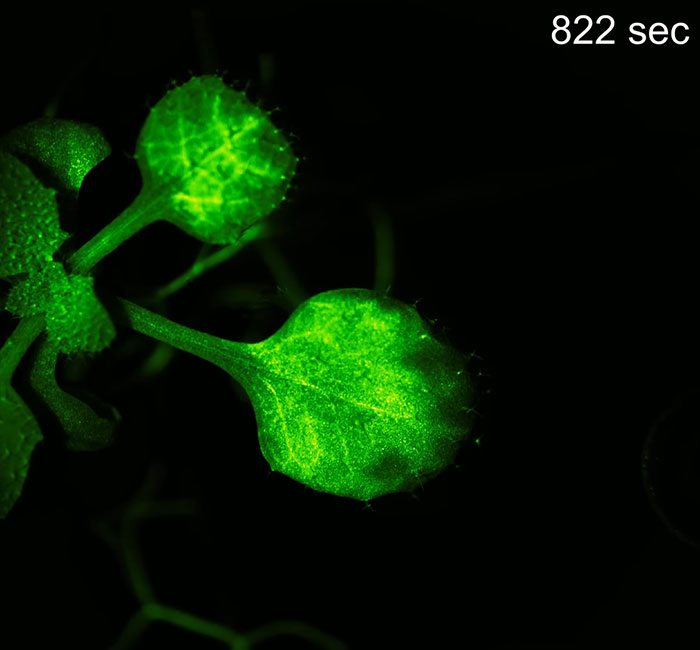
“Amazing” Video Of Plants Talking Has Social Media Reconsidering How They Thought About Life
As it turns out, plants chat among themselves. Japanese researchers have discovered how, also suggesting they even manage to defend themselves through airborne compounds, as shown in groundbreaking real-time footage.
A study, published in Nature Communications in October 2023, revealed that plants are surrounded by a fine mist of airborne compounds that they use to communicate and protect themselves.
- Plants communicate with airborne compounds to defend themselves.
- Real-time footage shows plant responses to volatile compounds.
- Researchers used genetically modified plants to study communication.
Despite a mechanism that has been known by scientists since the 1980s, detecting them in over 80 plant species since then, it is only now that actual footage has captured how plants receive and respond to these aerial alarms, thanks to a team of Japanese researchers.
A study revealed that plants are surrounded by a fine mist of airborne compounds that they use to communicate and protect themselves
Image credits: Chokniti Khongchum
Image credits: ScienceAlert
In this study, Yuri Aratani and Takuya Uemura, molecular biologists at Saitama University in Japan, and colleagues rigged up a pump to transfer compounds emitted by injured and insect-riddled plants onto their undamaged neighbors and a fluorescence microscope to watch what happened, Science Alert reported.
The researchers observed the response of an insect-free and intact Arabidopsis plant upon placing caterpillars on the leaves cut from separate tomato plants and Arabidopsis thaliana.
Researchers saw the response of an insect-free Arabidopsis plant upon placing caterpillars on the leaves cut from separated plants
Image credits: ScienceAlert
Genetically modified plants with a biosensor that fluoresces in response to calcium signals were used by the research team to study how plants communicate through calcium signaling.
The scientist subsequently observed how the plants reacted to volatile compounds released upon injury.
You can watch the plants’ responses below:
Image credits: ScienceAlert
Image credits: Aratani et al. Nature Communications, 2023
Footage of the experience showed the undamaged plants receiving the messages of their injured neighbors loud and clear, responding with bursts of calcium signaling that rippled across their outstretched leaves, as per Science Alert.
Analyzing the airborne compounds, the researchers reportedly found that two compounds, called Z-3-HAL and E-2-HAL, induced calcium signals in Arabidopsis.
Plants with a biosensor that fluoresces in response to calcium signals were used by the research team to study how plants communicate through calcium signaling
Image credits: Aratani et al. Nature Communications, 2023
The scientists further pinpointed the initial responders to danger signals by genetically modifying Arabidopsis plants with fluorescent sensors in specific cell types, including guard cells (surface cells forming stomata), mesophyll cells (inner leaf tissue), and epidermal cells (outermost leaf layer).
The study showed that when Arabidopsis plants were exposed to Z-3-HAL, guard cells generated calcium signals within a minute or so, after which mesophyll cells picked up the message, Science Alert reported.
Image credits: Aratani et al. Nature Communications, 2023
Additionally, pre-treating plants with a phytohormone (a plant hormone) that shuts stomata (tiny openings present on the epidermis of leaves) significantly reduces calcium signaling, suggesting stomata act as the “nostrils” of the plant.
Masatsugu Toyota, a molecular biologist at Saitama University in Japan and senior author of the study, said: “We have finally unveiled the intricate story of when, where, and how plants respond to airborne ‘warning messages’ from their threatened neighbors.
“This ethereal communication network, hidden from our view, plays a pivotal role in safeguarding neighboring plants from imminent threats in a timely manner.”
“They are amazing,” a reader exclaimed
Poll Question
Thanks! Check out the results:
This comment made me happy :) I tend to focus on the things that suck but you reminded me that maybe not everything does
Load More Replies...Plants are really much more alive and observat of their surroundings than the general public appears to belive. 🤓
When first reading i thought you'd left off the last three words
Load More Replies...This comment made me happy :) I tend to focus on the things that suck but you reminded me that maybe not everything does
Load More Replies...Plants are really much more alive and observat of their surroundings than the general public appears to belive. 🤓
When first reading i thought you'd left off the last three words
Load More Replies...
 Dark Mode
Dark Mode 

 No fees, cancel anytime
No fees, cancel anytime 


































































48
8